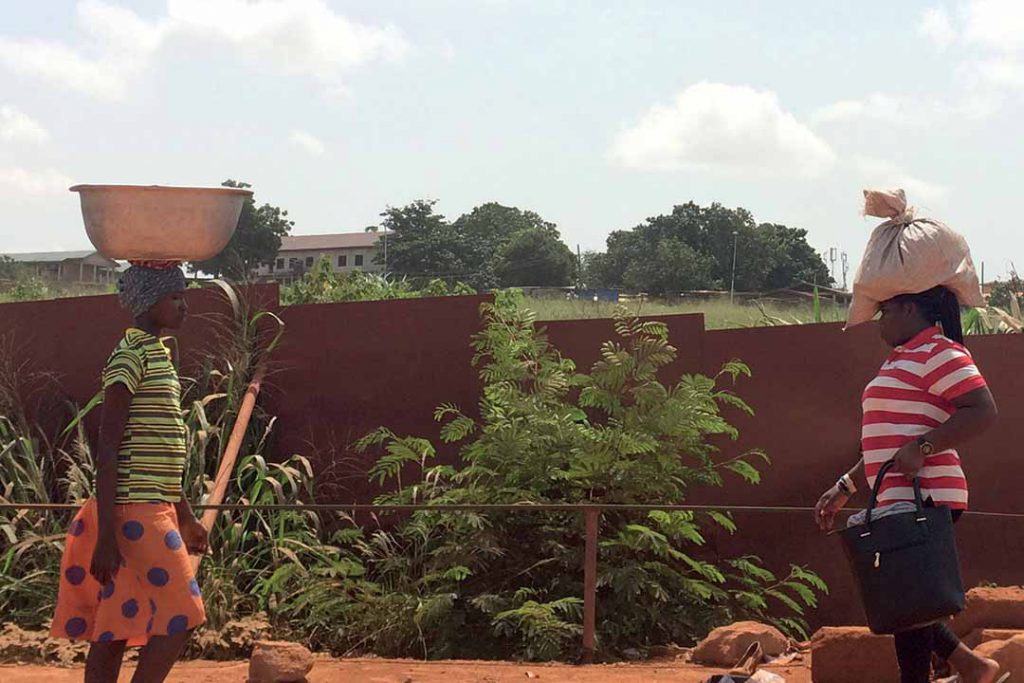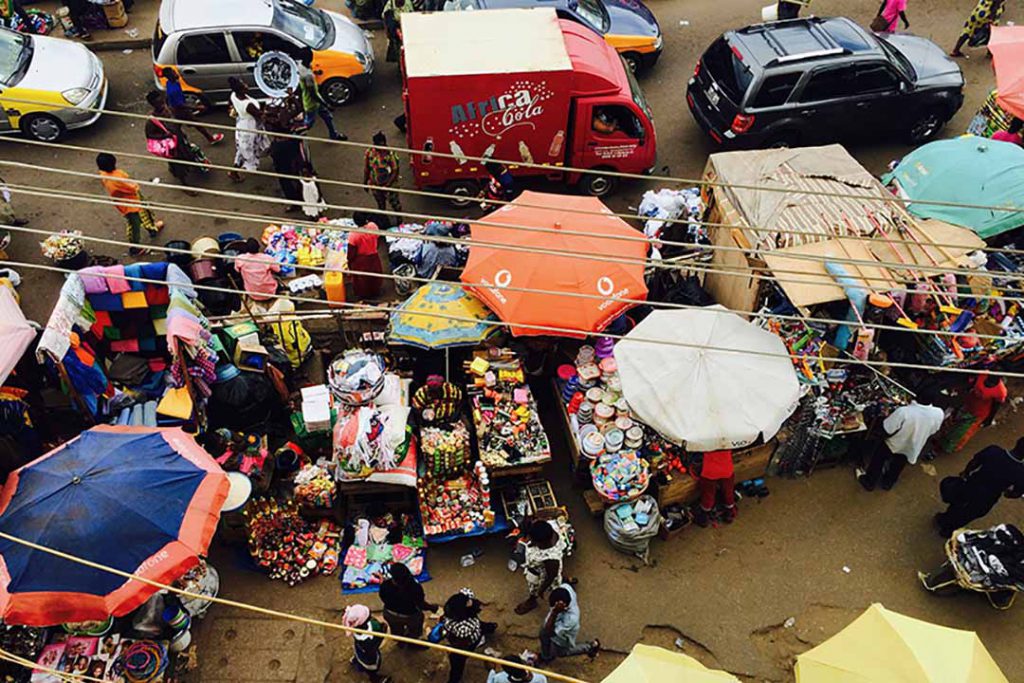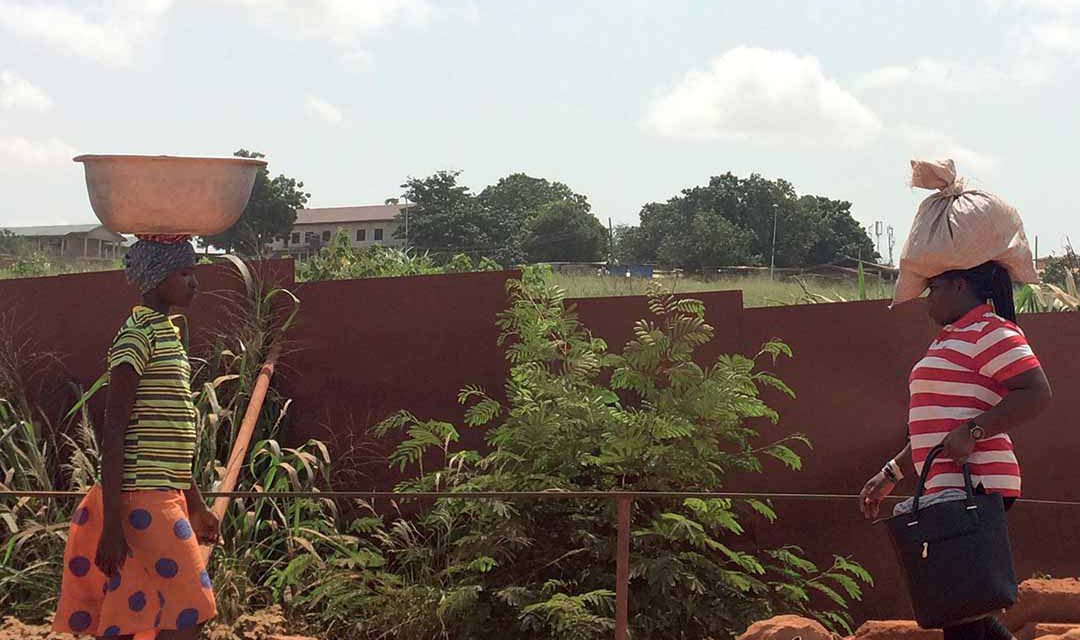
The dirt road connecting Kumasi Central Market to Race Course has developed as another space for petty trading Image supplied
In Kumasi, small traders face forced relocation as the government seeks to neaten up the country’s cities
It was late morning in May 2016, and Seth Ohene had made only GH¢10 ($2.28) in sales. “If I stay for the whole day, maybe I can make GH¢40 ($9.12),” he said. He had stationed his four-wheeled metal sales cart on a dusty, unpaved road midway between Kumasi Central Market and the trotro (minibus) station known as Race Course. The cart displayed womenswear in various colours, sizes and types, some suspended from hangers and some still in plastic packaging.
Other small traders had set up shop, spacing themselves out along the dusty road. Like Ohene, most of them used to trade near Kejetia, the public minibus station in Kumasi, the second-largest city in Ghana. Ohene himself had traded there for nine years. Thousands of commuters streamed in and out each day, he said, and he could make as much as GH¢400 ($91.12) a day.
“Here, you are selling, but it’s not every day that you get money,” Ohene said. “Today is good, tomorrow is not good. At Kejetia, I made enough to take care of my wife and two children. Government told us that we should move to Race Course, but they didn’t find a good place for us,” he said.
Kejetia is near the Kumasi Central Market, one of the largest public markets in west Africa. The Kumasi Metropolitan Assembly (KMA) estimates that 50,000 market vendors, traders, customers and commuters pass through the Central Market every day. Kejetia is one of the busiest transport stations in the city, with 1,000 market stall vendors and 2,500 petty traders like Ohene.

Seventy-five percent of Kumasi’s workforce is engaged in informal employment, and an estimated 300,000 small traders, locally referred to as “petty traders” or “hawkers”, operate throughout the city. But the KMA wants to transform Kumasi’s CBD into a more modern, organised space, delinking it from the city’s long-established tradition of open-air market trading. Traders like Ohene see the development as a threat to their livelihood, as they depend on small trading to make ends meet.
Kejetia and the Central Market were initially built in the 1920s. The Central Market – a series of roofed, open-air structures for 700 traders in the downtown area – was built as part of the colonial city government’s attempts to relocate traders from roadsides to designated trading spaces. Kejetia Lorry Park followed soon after, built on reclaimed swampland as a car park and bus loading area. Both expanded to become important commercial and transport spaces in the city’s central business district.
In early 2015, rumours spread among the small traders that the KMA was planning to build a new market, with Kejetia as the proposed site. In March that year, the KMA confirmed plans for the new market, made possible through a $298 million loan from the Brazilian government, with a Brazilian firm handling the market’s design, engineering and construction. The KMA gave Kejetia’s small traders two months to relocate to Race Course, an isolated minibus station further away from the Central Market. Market traders were moved to multi-storey commercial structures.
Kejetia traders protested and took the KMA to court, but in June 2015, the gates of Kejetia Lorry Park were barricaded. In a series of demolitions, the KMA flattened Kejetia, the traders’ structures and many of their goods. Months later, the government broke ground in the same spot, beginning the first phase of construction.
The government of Ghana’s “modern markets” initiative aims to develop similar spaces across the country. These new markets are a dramatic response to the spread of small traders in the city as well as constant market fires, which are frequent, happen quickly and spread rapidly, destroying market buildings, valuable capital and livelihoods. In January and March 2016, for example, fires at Kumasi Central Market gutted more than 200 shops and vendors’ property.
Markets, lorry parks and other public trading spaces are typically over-subscribed and under-resourced, plagued by deteriorating infrastructure and a lack of water, sanitation and drainage services, making the vending spaces vulnerable to fire. This despite the fact that many small traders contribute to government revenues. Kumasi’s small traders pay daily tolls, known as the KMA Hawkers Service Charge, directly to the KMA.
The Kejetia Petty Traders Association estimates that the average small trader at Kejetia pays around GH¢760 ($172.93) a year. According to recent research by the Institute for Development Studies based in Tamale, the KMA gathers an estimated 70% of its internally generated funds from street vendors’ tolls. The lack of congruence between traders’ contributions and corresponding investment in their commercial spaces is clear.
In an undated promotional brochure, the ministry of trade and industry promoted modern markets as the solution to the “proliferation of hawkers and itinerant traders and ramshackle structures”, as well as the “menace of market fires and other hazards”.

The new market in Kumasi’s CBD will consist of multiple levels with an estimated 6,000 stores, an open pavilion with space for 500 small traders, and a ground-level transport station. It will have space for less than half of the Central Market and Kejetia vendors and traders, putting into question the future of small traders who seem to be less and less part of the urban vision of city government leaders. And because of that, it might endanger the success of the market project itself.
The KMA maintains that spaces at Race Course were available to small traders for free. However, intermediary agents responsible for space allocation charged petty traders a minimum of GH¢200 ($45.40). Traders weren’t allowed to build permanent or roofed structures.
The practical conditions at Race Course are challenging. “This dust here is making me sick,” said Akua Konadu, sitting under an umbrella at her wooden tabletop kiosk and wiping down her bottles of engine oil on display. Konadu has gone from earning between GH¢500 ($113.50) and GH¢600 ($136.20) a day at Kejetia to between GH¢80 ($18.15) and GH¢100 ($22.70) – less than a quarter of what she was making before.
At Kejetia, she said, night security and storage areas provided safety, and she could accumulate and sell her goods from a small tabletop. At Race Course, there was no security, and she lost her stock when Kejetia was barricaded and then demolished. She also lost her regular customers, while fewer customers passed through Race Course.
During the rainy season, showers transform Race Course into a muddy swampland. Without roofs or other covered areas, rain soaks the traders trying to sell goods, and sends potential customers running.
Decreased sales, lost stock and absent customers mean lower incomes and more uncertainty for traders, their businesses and their households. These traders directly link their lower incomes to their forced relocation. Many traders struggle now more than ever to afford to keep their children in school. They and their families try to cope with the negative impact of the market redevelopment by sending their children to cheaper schools, withdrawing them altogether, or sending them to live with extended family members.

Hawkers service charge. Image supplied
“The KMA says this is a new market structure, but day in and day out, people are venturing into petty trading, and the numbers are increasing due to lack of [formal employment] opportunities,” said Eric Akwasi Prempeh, chairman of the Kejetia Petty Traders Association. The city, he added, should upgrade markets and lorry stations – but in ways that also protected traders’ access and livelihoods.
Traders needed to be taken into account in the city’s market plan, he argued, and they should also be part of the planning process. The traders’ vending activities were created and responded to customer demand, he said, so planning and designing with traders was an opportunity to leverage their “informal knowledge” of customer traffic and market flows.
The market and the lorry park’s basic infrastructure and services should be improved, traders’ occupational health and safety should be taken seriously, and preventing hazards like fires would also be necessary, Prempeh argued.
He also proposed that centres like the new market should be planned as mixed- use developments that integrate the small traders at street level, rather than forcing those who can afford it into multi- storey commercial buildings. “We need to respond to the realities of how buying and selling works in Kumasi,” he said.
Some of the Kejetia market stall vendors who were relocated found themselves trading in three and four- level structures where the second, third and fourth floors stood mostly empty because customers did not want to venture there.
“Without provision for these traders, the purpose of even building the new structure will be defeated,” Prempeh told Africa in Fact. Kumasi’s small traders want to be part of the city’s urban vision for the future. The extent to which they are included will determine the city’s overall success.
Victoria Okoye is an urban policies specialist with Women in Informal Employment: Globalizing and Organizing (WIEGO) and a PhD student at the University of Sheffield in the UK. A founder of African Urbanism, which explores West African cities’ development trajectories, she works on planning, researching and engaging informal, street-level spatial appropriation in West African cities.













